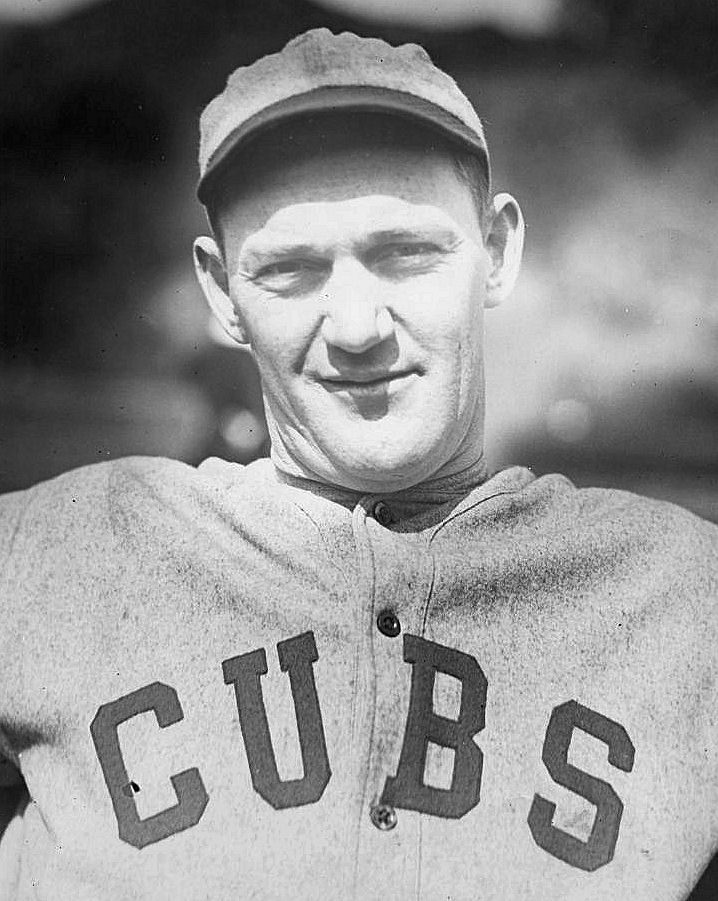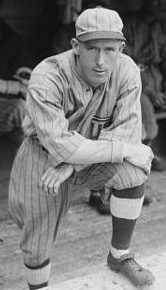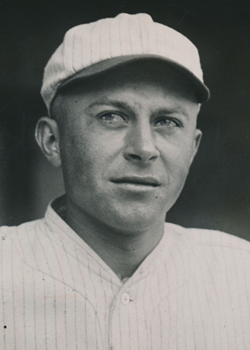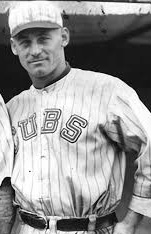|
Pivotal World Series Moments
Whiteman's Somersault Catch
1918 World Series Game 6: Chicago Cubs @ Boston Red Sox
After the players' strike almost led to the postponement of Game 5 the day before, fans had to wonder if Game 6 would be played as scheduled. But the players, having given up on the Commission, relied on their team owners to increase their compensation after a season, and a World Series, that had been shortened by U.S. participation in World War I. Both Charley Weeghman (Cubs) and Harry Frazee (Red Sox) assured the players committee that they would try to find a way to increase their payout.
Only 15,238 showed up for Game 6 on a bright but chilly early fall day–the smallest World Series crowd since 1909. They saw a well-pitched game in which all three runs were scored in the third and fourth innings although it took a sensational catch in the eighth inning to preserve Boston's lead.
    L-R: Carl Mays, Lefty Tyler, Harry Hooper, George Whiteman Cubs manager Fred Mitchell countered with curve-balling Lefty Tyler, the 3-1 winner in Game 2 who was going on just one day's rest after hurling seven innings in Game 4.
The Red Sox struck first with two in the bottom of the third with some help from Tyler's wildness and the Chicago defense. Lefty committed a cardinal sin by walking his opposing moundsman to start the inning. RF Harry Hooper sacrificed Mays to second. After 2B Dave Shean drew another walk, both runners moved up a base on CF Amos Strunk's grounder to second. LF George Whiteman cracked a liner to the sun field that RF Max Flack dropped to allow both runners to score. One writer described the play this way: "Flack came running in to make an easy catch. He caught up to the rapidly descending ball an had it entirely surrounded by his hands. Tyler was offering thanksgiving for crawling out of a bad hole when the ball squeezed its way through Flack's buttered digits."
Whiteman had also made a "circus catch" to help make the Red Sox 2-1 lead hold up in Game Three. was a grizzled 35-year-old who had played in just 15 major league games in brief stints with the Red Sox in 1907 and the Yankees in 1913. The Red Sox lost their left-fielder from what was generally regarded as the best outfield in the American League if not in all of baseball. Duffy Lewis spent 1918 in the Navy coaching a baseball team in California. Boston's CF Tris Speaker had played with Whiteman in the Texas League. In fact, the Red Sox acquired the future Hall of Famer because of Whiteman. When Boston tried to buy Whiteman from Houston, the minor league club's owner insisted that Boston take Speaker also. Tris owed Whiteman and persuaded the Red Sox to acquire Whiteman to replace Duffy.
The Cubs cut the lead in half in the fourth but missed a chance to tie or take the lead. Flack started the uprising with a single to center and advanced to second on SS Charlie Hollocher's groundout. LF Les Mann was hit by a pitch but quickly picked off first by C Wally Schang. After CF Dode Paskert walked, Flack stole third. 1B Fred Merkle's single knocked in Flack before 2B Charlie Pick lined out.
   L-R: Max Flack, Charlie Hollocher, Les Mann The Sox loaded the bases with one out in the bottom of the 4th but did not add to their lead. Neither team got more than one man on base in any inning until the top of the 8th.
Manager Mitchell chose Turner Barber to pinch hit for 3B Charlie Deal to lead off the inning. Mays delivered a pitch around the batter's knees, and Barber reached down and smacked it toward Whiteman in left field. One report of the game described what happened next this way: "Whiteman, before the series hardly known to baseball fame, rushed in with the ball dropping faster and faster, grabbed the sphere below his akles and took a clean somersault, the great momentum rolling him up on his feet again. He staggered dizzily, but with great elation, slammed the ball to (SS Everett) Scott and the ball went flying around the infield as an expression of the joy of the Sox in such a remarkable catch."
When Whiteman's teammates came out to check on him, he waved them off, but after the next out was made, Whiteman came to the dugout with an injured neck as the crowd gave him a standing ovation. His replacement in left field was one of the Red Sox starting pitchers, 23-year-old Babe Ruth.
Mays retired the remaining four batters to wrap up the Red Sox fifth World Series championship in the 15 years that the Fall Classic had been held, including three in the last four years..
When the war ended that fall, Lewis returned to the Red Sox for the 1919 season, and George Whiteman never played in another major league game.
|